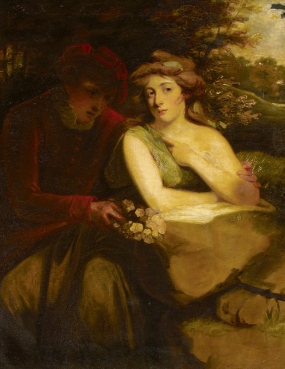
This intriguing painting tells the story of Vertumnus and Pomona, two characters from Roman Mythology. Their story was told in the Metamorphoses by Ovid, which has been a popular source of inspiration for artists for several centuries. Vertumnus is a god with multiple roles. He is the god of seasons, of plant growth, gardens and fruit trees and also possessed the remarkable power to change his form at will.
Vertumnus was captivated by the beautiful Pomona who tended a lush and bountiful orchard, to which Vertumnus was unable to gain entry. Using his special power Vertumnus disguised himself as an old woman in order to enter Pomona’s orchard, whereupon he changed back to his true youthful self. Dressed in red cloak and hat, the colour of passion, Vertumnus attempts to edge closer to Pomona. His body is half-lit as though he has just emerged from the shadows. His arm tentatively reaches around that of Pomona, her bare shoulder offering him all the encouragement he needs to continue. Vertumnus offers a circlet of white flowers for her to decorate her long brown hair. It is at this moment she succumbs to his charms. Her eyes, once staring wistfully into the distance, give her changed intentions away. Her posture is changing from defensive to receptive and her new-found love is signified by her left arm which aligns to her heart but points to the eyes of Vertumnus.
The painting is by John Hoppner, a talented artist whose portrayal of women and children met with much acclaim during his lifetime. He was born of German parents, his mother working as an attendant to King George. The King took a keen interest in the development of Hoppner, giving rise to rumours that he was the King’s illegitimate son, but there is no truth to this. Hoppner did however become portraitist to many prestigious and Royal sitters and his work can be seen today in galleries around the world.
This painting can be seen hanging at Petworth House, a late 17th century house looked after by the National Trust. The house can be found at Park Road, Petworth GU28 0AE and is open daily.
Why you should see this painting
At the most romantic time of the year, this work reminds us that happy endings do sometimes happen. True love prevails once the charades are discarded and Pomona sees Vertumnus for who he really is.
First published in Sussex Life February 2017